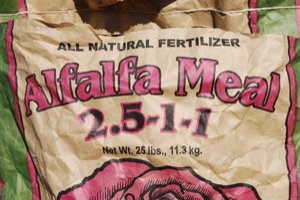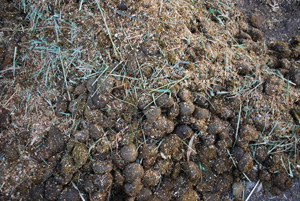What is the Best Organic
NPK Fertilizer?
What is NPK?

|
|
© Steve Masley…Click IMAGE to Enlarge |
An npk fertilizer is usually thought of as a chemical fertilizer, but npk applies to any soil amendment that supplies Nitrogen, Phosphorous, and K, Potassium, including organic fertilizers.
The numbers are always in the same order, and refer to the percentage of each element in the fertilizer.
Plants need nitrogen for leaf growth, phosphorus for root formation, stem growth, and fruiting, and potassium for flowering and plant immunity.
An organic npk fertilizer can be slow-releasing or fast-releasing. Many have both quick-releasing “labile” nutrients, and more “recalcitrant” nutrients that break down slowly and supply a steady stream of nutrients over a longer period.
Many organic npk fertilizers need soil organisms to break them down and release their nutrients, so they release more quickly when the soil is warm and the soil food web is at its most active. This is also when you get the most rapid plant growth, and your vegetables really need it.
If you’re growing cool-season vegetables, choose an organic npk fertilizer that breaks down under cooler soil temperatures. See Organic NPK Fertilizers for Cool-Season Vegetables.
Balanced Organic NPK Fertilizers
|
Animal Manures
|
(N) itrogen
|
(P) hosphorus
|
(K) Potassium (Potash)
Calcium
Balanced Organic NPK Fertilizers
A “balanced” organic npk fertilizer is one that provides nitrogen, phosphorus, and potassium—the main macronutrients needed by plants.
If you’re looking for a balanced organic npk fertilizer, your choices are generally plant-based, manure-based, or blended. Plant-based npk fertilizers include alfalfa meal, soy meal, and cottonseed meal. Note: Use only cottonseed meal from organic cotton. Conventionally grown cotton has some of the highest pesticide application rates in the country, and usually contains pesticide residues.
Worm Castings are probably the best single-constituent organic balanced npk fertilizer. They provide quick-release nutrients for early growth, as well as slower-releasing nutrients to sustain growth through the season. They also provide beneficial bacteria and fungi to help your plants assimilate these nutrients.
Alfalfa Meal is a close second. It’s a balanced npk fertilizer that provides a steady release of nitrogen, phosphorus, potassium, and some sulfur throughout the growing season, with most of it available during peak growth, when crops need it most. It’s also widely available, relatively cheap, light enough to use in container gardens, and doesn’t attract animals.
For most vegetables, I amend the soil with good compost or worm castings, and a blend of alfalfa meal for early growth, feather meal for late-season growth, and several other organic npk fertilizer components, for phosphorus, potassium, calcium, and trace minerals. For summer vegetables, I also inoculate the seedling roots with endo-mycorrhizae, to help the plants assimilate nutrients from the soil.
Sound complicated? It needn’t be. There are several good organic npk fertilizer blends on the market, that include mycorrhizae, as well as basic organic soil amendments. Dr. Earth Organic Tomato, Vegetable, and Herb Fertilizer
is a reliable standard, as is Foxfarm’s Peace of Mind Organic Tomato & Vegetable Fertilizer

. Both contain mycorrhizal inoculants.
Down To Earth All Purpose Blend
and Fox Farm Marine Cuisine Fertilizer

are also good balanced blends. Any one of them will serve as an npk fertilizer for your garden.
| Soil Amendment | N-P-K | Description | Lasts | Application Rate |
|---|---|---|---|---|
|
Alfalfa Meal |
2-1-2 | A quick-to-mid-release, balanced source of N, P, K, and some Sulfur. In my experience, one of the best balanced organic npk fertilizers. | 3-4 Months | Up to 16lbs/100 sq ft, 1 cup for 5gal pot |
|
Worm Castings |
3.2-1.1-1.5 | Excellent quick-release source of N, with a long-term, slow-release component. Inoculates soil with beneficial fungi & microbes from the worm gut. | 3-6 Months | 1” layer (10-15lbs/100 sq ft) Use up to 1/3 volume in container mixes. |
| Soy Meal | 7-2-1 | Be sure to mix into soil. If left in clumps you will have maggots. | 3-4 Months | Up to 16lbs/100 sq ft, 1 cup for 5-7gal pot |
| Cottonseed Meal | 5-2-1 | Slightly acidic, a good choice for acid-loving plants like berries. May contain pesticide residues, although organic sources are available. | 3-4 Months | Up to 8lbs/100 sq ft |
Poultry and Animal Manures
Poultry and animal manures have been used as organic fertilizers for centuries. If used correctly, they remain among the best npk fertilizer options for organic gardeners today.

|
|
© Steve Masley…Click IMAGE to Enlarge |
Manures are nicely balanced, providing small amounts of nitrogen, phosphorus, and potassium, in a base of predigested organic matter. Mixed into the soil, this is a soil food web banquet. Remember the organic gardener’s mantra: “Feed the soil to feed the plants”.
For most manures, only about 33% of the nitrogen is available the first year. The remaining nitrogen is bound up in organic matter—the bodies of soil organisms that multiply when you mix manure into soil—and mineralized into plant-available form at about 5% per year.
If you’re adding manure every year, be sure to factor in this 5% annual contribution from previous applications in determining how much manure to apply.
|
Organic Fertilizers |
|---|
|
|
|
|
|
|
|
|
Poultry manure is an exception. Up to 75% of the nitrogen it contains is available in the first year.
See Improving Garden Soil for ways to increase soil organic matter (SOM). See The Soil Food Web to learn how increased SOM becomes fertilizer for your vegetables.
Poultry and animal manures should always be composted prior to use around food crops—especially any edible part of the plant in contact with the ground. For organic farms, the last raw manure application has to be at least 120 days (4 months) before harvest. There are few restrictions on applications of composted manure.
Composting Manure:
- Kills pathogens like e. coli and salmonella.
- Kills weed seeds that make it through the digestive systems of livestock.
- Degrades and denatures antibiotics, hormones, and vermicides that are given routinely to poultry and livestock in factory farm settings.
- Degrades pesticide residues that may be present in partially digested feed or bedding.
Note: The NPK numbers for manure listed below should be seen as ballpark figures.
Actual NPK depends on
- The health of the animals
- The quality of the pasture or feed used
- The amount and type of bedding mixed in
- How the manure was handled and stored
- How it is applied to the soil
Manure with bedding mixed in has fewer nutrients by volume, but provides a better boost to soil organic matter. Poor storage can result in nitrogen losses up to 60%. Surface application, without incorporation into the soil, can result in losses of 20-30% in a few days.
As an npk fertilizer on farms, manure has several problems.
Excess or untimely application can contaminate groundwater with nitrates. Manure also tends to acidify soils with continuous application, and in some soils, salt concentrations increase, especially when steer manure is used.
These problems are rarely an issue for home gardeners, but you should be aware of them.
| Soil Amendment | N-P-K | Description | Lasts | Application Rate |
|---|---|---|---|---|
| Chicken Manure | 1.1-0.8-0.5 | Excellent quick-release source of N. Poultry manure releases up to 75% of its N the first year in the soil, compared with 33% for most other manures. | 3-12 Months | 1/2-1” layer (5-10 5-gal buckets/100 sq ft) |
| Steer Manure | 0.7-0.3-0.4 | Cheap and readily available organic N source. May contain excess salts. | 3-12 Months | 1-1.5” layer (10-15 5-gal buckets/100 sq ft) |
| Dairy Cow Manure | 0.25-0.15-0.25 | Less N-P-K than steer manure, but also less salt. More can be applied, so dairy cow manure is better for increasing SOM. | 3-12 Months | 1-2” layer (10-20 5-gal buckets/100 sq ft) |
| Horse Manure | 0.7-0.3-0.6 | High N, but bedding mixed in (especially saw-dust) may limit availability. May contain weed seeds or pharmaceutical vermin-cides. Composting first eliminates all of these problems. | 3-12 Months | 1” layer (10 5-gal buckets/100 sq ft) |
| Pig Manure | 0.8-0.7-0.5 | Good, balanced manure source of N, P, and K. Because some pig parasites and pathogens can infect humans, pig manure is not allowed in many organic protocols. If it is used, it must be hot-composted prior to use. | 3-12 Months | 1” layer (10 5-gal buckets/100 sq ft) |
| Sheep Manure | 0.7-0.3-0.9 | Good manure source for N and K, with some P. Superior to cow manure, if you have a good local source for it. | 3-12 Months | 1-2” layer (10-20 5-gal buckets/100 sq ft) |
| Rabbit Manure | 2.4-1.4-0.6 | Richest manure N source, more than double the N of chicken manure. Will burn plants if not composted first. GREAT addition to the compost pile, if you know someone with bunnies. | 3-12 Months | 1/2” layer (5 5-gal buckets/100 sq ft) |
Top of Page
Trace Minerals
Trace Minerals are minerals—like boron, copper, magnesium, and manganese—that plants need only in small quantities. They’re important for specific enzymatic reactions, and adequate levels improve plant immunity and adaptability to temperature and drought stresses. Most become toxic in larger amounts.
| Soil Amendment | N-P-K | Description | Lasts | Application Rate |
|---|---|---|---|---|
|
Kelp Meal |
1-0-1.2 Trace Minerals |
Important source of organic potash & trace minerals. Excellent in seed starting mixes--boosts growth & reduces damping-off & fungal problems in seed starts. Encourages microbial populations. Contains plant growth hormones--do not over-apply! | 6-12 Months | Up to 1lb/100 sq ft --but no more! |
| Rock Dust (Crushed Granite) | 0—3-5—0, trace minerals |
Granite fines, the dust from rock grinding and sorting operations. Very slow releasing P source, good source of trace minerals for plant immunity and tolerance of temperature extremes. | 5-10 Years | Up to 8.5lbs/100 sq ft |
Top of Page
Top of Trace Minerals Section
Organic Fertilizers
|
(N)itrogen
|
(P)hosphorus
|
(K) Potassium
Calcium
Copyright © 2009-2025, by Steve Masley, Grow-it-Organically.com
All rights reserved
HOME | About Us | Contact Us | Privacy
New! Comments
Have a question or comment about what you just read? Leave me a comment in the box below.